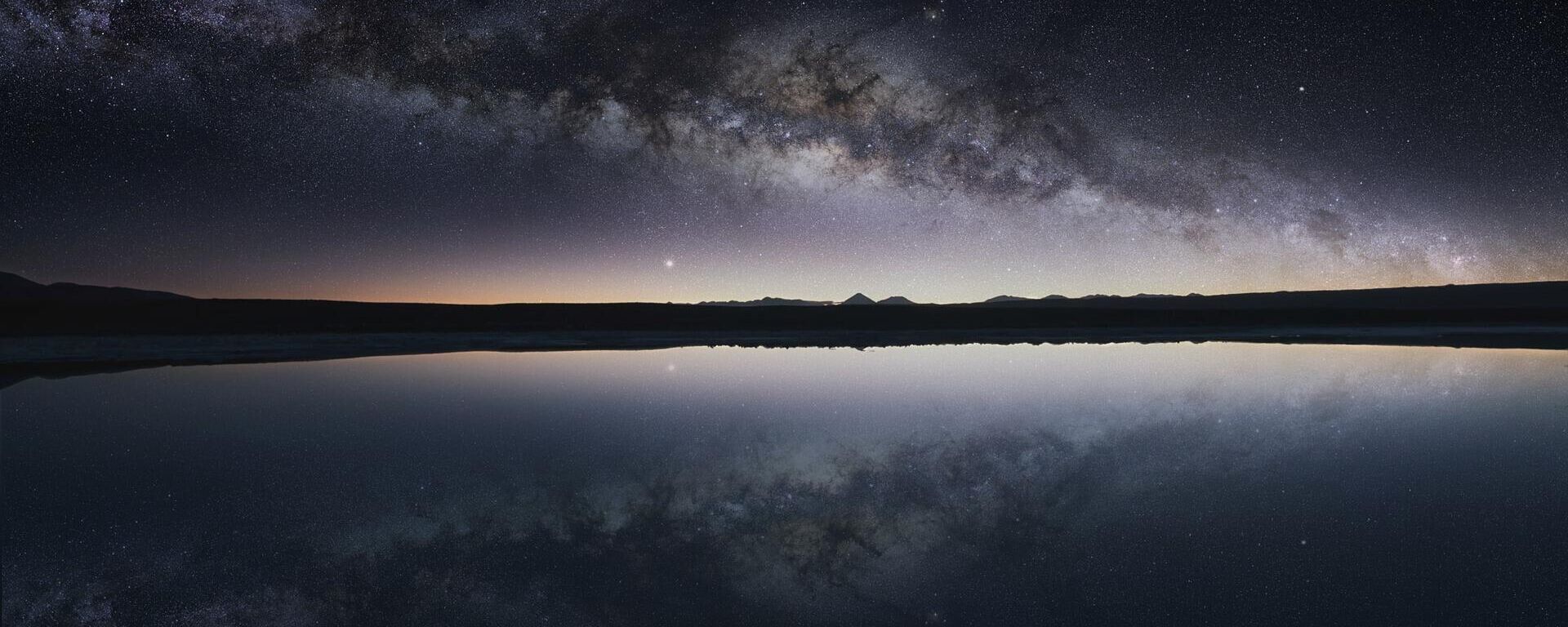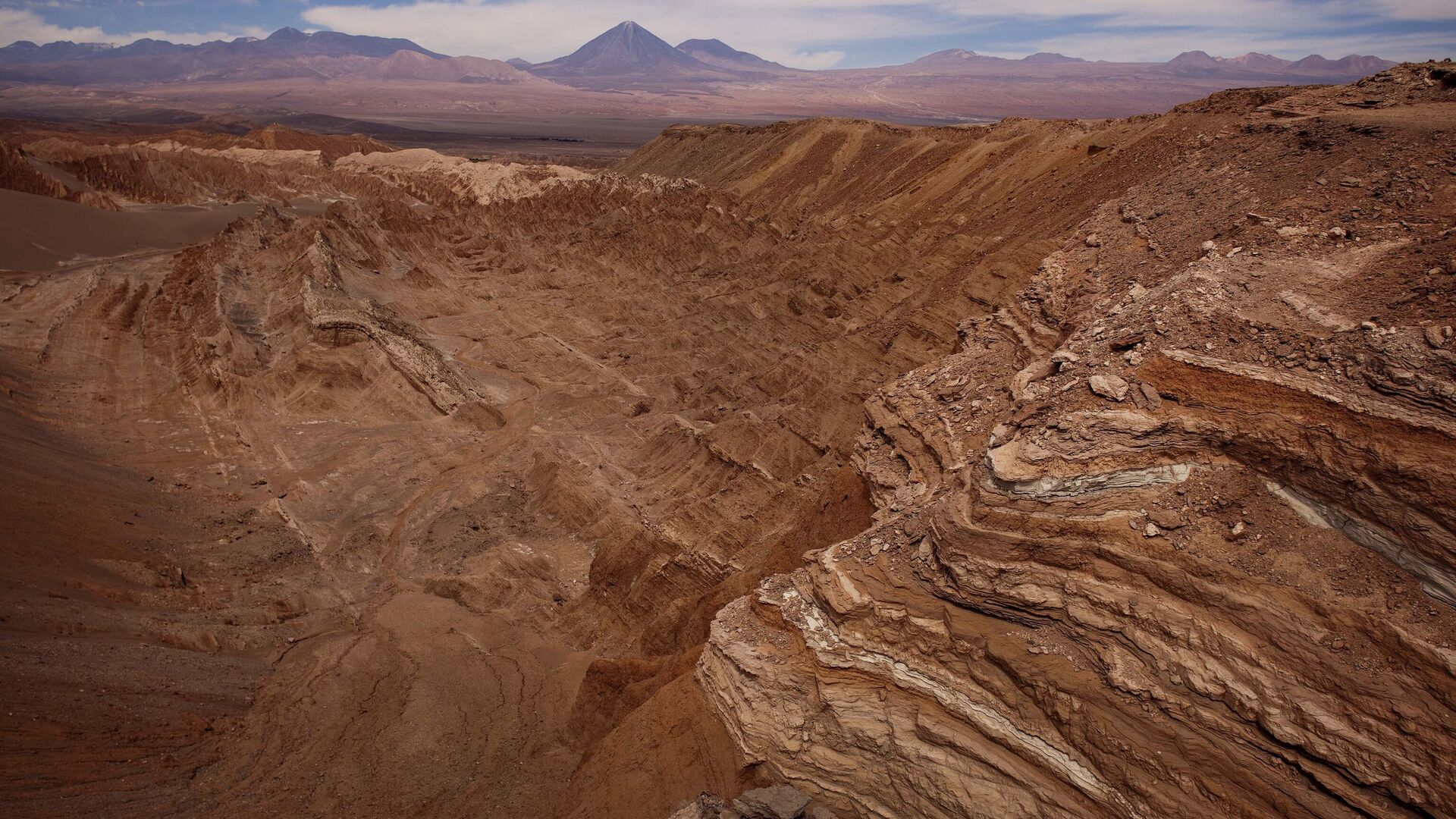https://sputnikglobe.com/20230724/atacamas-altiplano-sets-incredible-solar-irradiance-world-record-1112107967.html
Atacama's Altiplano Sets 'Incredible' Solar Irradiance World Record
Atacama's Altiplano Sets 'Incredible' Solar Irradiance World Record
Sputnik International
Chile's Atacama Desert boasts the planet's hottest spot, setting world records for solar luminosity, but experts warn of extreme radiation risks. 24.07.2023, Sputnik International
2023-07-24T15:18+0000
2023-07-24T15:18+0000
2025-04-07T11:07+0000
beyond politics
ray cordero
earth
venus
atacama desert
american meteorological society
viral news
https://cdn1.img.sputnikglobe.com/img/07e7/02/18/1107773047_0:160:3073:1888_1920x0_80_0_0_aa95a4b7e33a4fcff57ce29da3b85c83.jpg
Situated on the scorched tableland close to the Chilean Andes is the Altiplano of the Atacama Desert, a place scientists have designated as the hottest site on Earth, with sufficient sunlight comparable to Venus, the second planet from the Sun.The Altiplano is usually dehumidifying and chilly, and rests approximately 13,120 ft (4,000 meters) above sea level. This spot receives more sunshine than other locations near the equator or at a higher altitude, science journal Bulletin of the American Meteorological Society revealed.Why is the Atacama Desert Special?The desert is the oldest on Earth, the most arid, and peradventure offers the most advantageous site for viewing the alluring night sky.The Chilean Altiplano is exceptional in terms of solar luminosity reaching Earth. According to the study, the plateau holds a world record of 2,177 watts per square meter, beating the radiation recorded (roughly 1,360 watts per square meter) at the highest point of the Earth’s atmosphere. However, the plateau’s average solar irradiance is approximately 308 watts per square meter - another world record that surpasses Central Europe and US East Coast records twofold.Cordero expressed that the comparison is insightful, given that 28 percent of the planet Venus is stationed closer to the Sun than the Earth.Chile's location in the Southern Hemisphere is a key determinant of its sunny weather. During summer, particularly when the Earth’s orbit is nearer the Sun, attaining a perihelion phase in early January increases solar intensity by seven percent in the Southern Hemisphere more than in the Northern Hemisphere, as documented by the American Meteorological Society.Cordero told media sources that people who work in this place are susceptible to high radiation exposure, and that it would have adverse effects on their skin.
https://sputnikglobe.com/20230224/mystery-dna-of-organisms-unknown-to-science-found-in-chiles-atacama-desert--1107771827.html
earth
venus
atacama desert
Sputnik International
feedback@sputniknews.com
+74956456601
MIA „Rossiya Segodnya“
2023
Chimauchem Nwosu
https://cdn1.img.sputnikglobe.com/img/07e7/09/01/1113046371_0:99:1536:1635_100x100_80_0_0_9c5c627283eca931c39fe4852bbb301c.jpg
Chimauchem Nwosu
https://cdn1.img.sputnikglobe.com/img/07e7/09/01/1113046371_0:99:1536:1635_100x100_80_0_0_9c5c627283eca931c39fe4852bbb301c.jpg
News
en_EN
Sputnik International
feedback@sputniknews.com
+74956456601
MIA „Rossiya Segodnya“
Sputnik International
feedback@sputniknews.com
+74956456601
MIA „Rossiya Segodnya“
Chimauchem Nwosu
https://cdn1.img.sputnikglobe.com/img/07e7/09/01/1113046371_0:99:1536:1635_100x100_80_0_0_9c5c627283eca931c39fe4852bbb301c.jpg
atacama desert, altiplano, chilean andes, hottest site on the planet, venus, solar luminosity, solar irradiance, raul cordero, university of groningen, southern hemisphere, northern hemisphere, perihelion phase, high radiation exposure, adverse effects, night sky, aridest desert, oldest desert, viewing the night sky, world record solar luminosity, american meteorological society, climate research, desert climate, solar intensity, high-altitude desert, extreme environment, chilean climate, extreme radiation, venus comparison, sun exposure effects, atacama weather, chilean desert climate, solar radiation.
atacama desert, altiplano, chilean andes, hottest site on the planet, venus, solar luminosity, solar irradiance, raul cordero, university of groningen, southern hemisphere, northern hemisphere, perihelion phase, high radiation exposure, adverse effects, night sky, aridest desert, oldest desert, viewing the night sky, world record solar luminosity, american meteorological society, climate research, desert climate, solar intensity, high-altitude desert, extreme environment, chilean climate, extreme radiation, venus comparison, sun exposure effects, atacama weather, chilean desert climate, solar radiation.
Atacama's Altiplano Sets 'Incredible' Solar Irradiance World Record
15:18 GMT 24.07.2023 (Updated: 11:07 GMT 07.04.2025) Chile's Atacama Desert boasts the planet's hottest spot, setting world records for solar luminosity, but experts warn of extreme radiation risks.
Situated on the scorched tableland close to the Chilean Andes is the Altiplano of the
Atacama Desert, a place scientists have designated as the hottest site on Earth, with sufficient sunlight comparable to Venus, the second planet from the Sun.
The Altiplano is usually dehumidifying and chilly, and rests approximately 13,120 ft (4,000 meters) above sea level. This spot receives more sunshine than other locations near the equator or at a higher altitude, science journal
Bulletin of the American Meteorological Society revealed.
Why is the Atacama Desert Special?
The desert is the oldest on Earth, the most arid, and peradventure offers the most advantageous site for viewing the alluring night sky.

24 February 2023, 14:38 GMT
The Chilean Altiplano is exceptional in terms of solar luminosity reaching Earth. According to the study, the plateau holds a world record of 2,177 watts per square meter, beating the radiation recorded (roughly 1,360 watts per square meter) at the highest point of the Earth’s atmosphere. However, the plateau’s average solar irradiance is approximately 308 watts per square meter - another world record that surpasses Central Europe and US East Coast records twofold.
"It's actually the radiation that you will be receiving in summer if you are standing up on Venus," noted Raul Cordero, lead study author and a climatologist at the University of Groningen in the Netherlands.
Cordero expressed that the comparison is insightful, given that 28 percent of the planet Venus is stationed closer to the Sun than the Earth.
Chile's location in the Southern Hemisphere is a key determinant of its sunny weather. During summer, particularly when the Earth’s orbit is nearer the Sun, attaining a perihelion phase in early January increases solar intensity by seven percent in the Southern Hemisphere more than in the Northern Hemisphere, as documented by the American Meteorological Society.
Cordero told media sources that people who work in this place are susceptible to high radiation exposure, and that it would have adverse effects on their skin.




